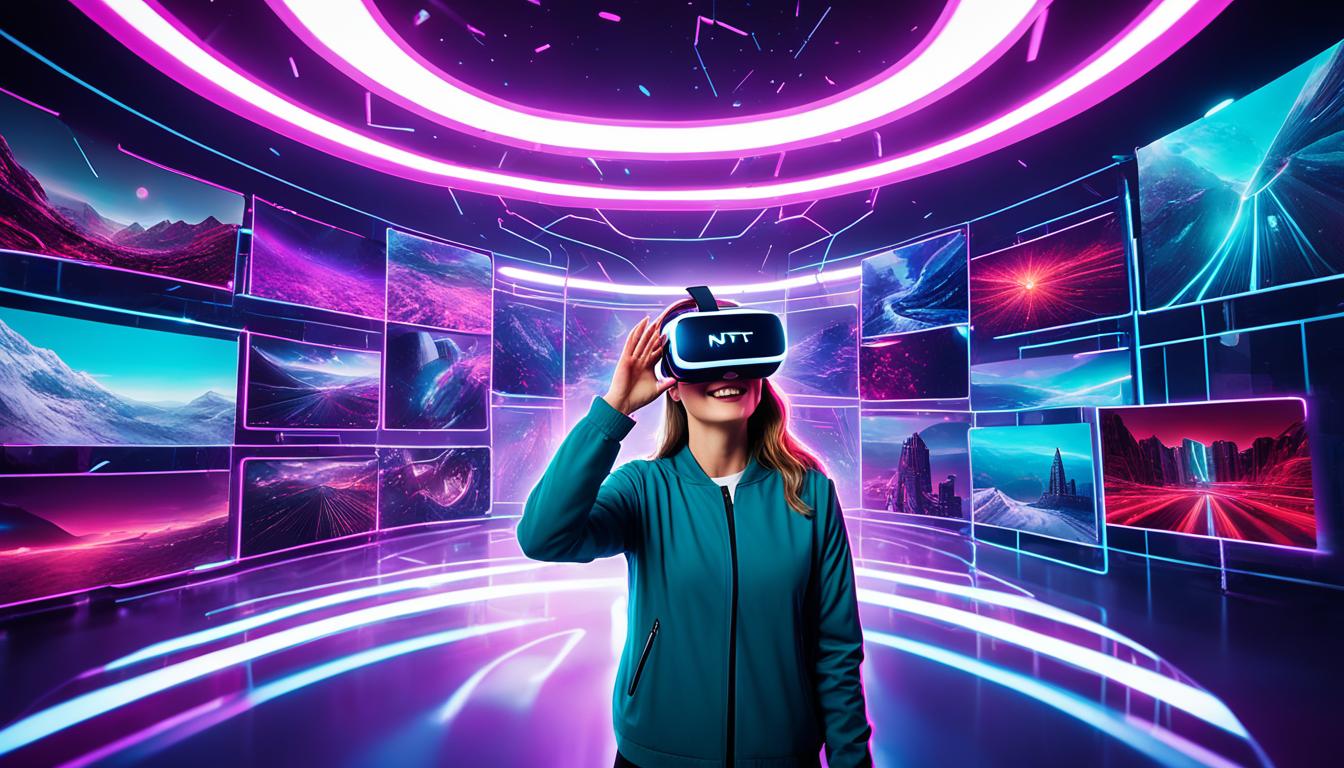Did you know that the global market for non-fungible tokens (NFTs) is projected to reach a staggering $470 million by the end of 2021? Meanwhile, the virtual reality (VR) industry is expected to surpass $20 billion by 2024. These two technological advancements are converging to create a profound impact on the digital landscape, revolutionizing the way we perceive and interact with digital assets.
As we dive into the relationship between NFTs and VR, we uncover a world of possibilities that extend beyond traditional digital ownership and immersion. NFTs, powered by blockchain technology, offer a way to authenticate and establish ownership of unique digital assets, while VR creates immersive environments that transport users into virtual worlds.
The synergy of NFTs and VR opens up exciting avenues for artists, collectors, gamers, and businesses alike. From immersive art experiences and virtual real estate ownership to enriching gaming adventures, this convergence is reshaping various industries and paving the way for unique and engaging digital experiences.
Key Takeaways:
- NFTs and VR are two cutting-edge technologies that are merging to transform the digital landscape.
- NFTs authenticate ownership of unique digital assets through blockchain technology.
- VR creates immersive environments that mimic reality, offering lifelike experiences.
- VR NFTs enable users to own and interact with digital assets in virtual worlds.
- The combination of NFTs and VR presents new opportunities in immersive art, virtual real estate, and gaming experiences.
The Synergy of NFTs and Virtual Reality
Virtual Reality (VR) Non-Fungible Tokens (NFTs) have emerged as a powerful combination, enabling users to access immersive virtual worlds and experiences. With VR technology, users can own and interact with digital assets in these virtual environments, ranging from virtual art and collectibles to virtual real estate and gaming experiences. This synergy between VR NFTs and virtual reality opens up new possibilities for artists, investors, gamers, and virtual enthusiasts alike.
VR NFTs revolutionize the concept of digital ownership, offering a unique way for collectors and art enthusiasts to engage with immersive art. Through VR platforms, artists can push the boundaries of creativity, using virtual reality as a canvas to create captivating digital artworks. These VR NFT-based artworks can be owned, traded, and displayed within virtual galleries, providing users with an interactive and visually stimulating art experience. Immersive art has become an exciting new medium, bridging the gap between traditional art forms and cutting-edge technology.
In addition to immersive art, VR NFTs redefine the notion of virtual real estate. Blockchain technology enables the buying, selling, and trading of virtual lands in virtual reality environments. Virtual real estate offers users the opportunity to explore and inhabit expansive virtual worlds, each with its unique characteristics and potential for development. Just like physical real estate, virtual land can appreciate in value, making it an attractive investment for those seeking to capitalize on the virtual revolution.
Gaming experiences are also enhanced by the integration of VR NFTs. In virtual reality gaming, players are transported into lifelike environments where in-game assets are represented as NFTs. This allows for true ownership and trading of in-game items, giving players a sense of rarity and exclusivity. The immersive nature of VR gaming creates a more engaging and realistic gameplay experience, making it highly appealing to gamers seeking a deeper level of immersion.
VR NFTs provide a unique opportunity for artists to push the boundaries of creativity, investors to explore new digital assets, and gamers to experience immersive gameplay like never before.
Furthermore, the combination of VR NFTs and virtual reality has the potential to revolutionize the way we shop in the digital realm. Virtual shopping experiences using VR technology provide customers with the ability to browse and try on products, visualizing them in a virtual environment before making a purchase. This immersive approach to e-commerce enhances the customer experience, offering a more realistic and interactive shopping journey.
With VR NFTs and virtual reality, we are witnessing a convergence of technology that holds immense potential for the future of digital experiences. From immersive art and virtual real estate to gaming experiences and virtual shopping, VR NFTs are transforming the way we engage with the virtual world, creating new opportunities and possibilities for creators, investors, and consumers alike.
The Future of NFTs and Virtual Reality
As we look ahead, the future of NFTs and virtual reality holds immense potential. Augmented reality (AR) NFTs combine the real world with computer-generated information, offering users the opportunity to engage with interactive content within their surroundings. Imagine exploring an art gallery where digital masterpieces come to life on the walls of your own home.
Moreover, the rise of VR NFT games is set to revolutionize the gaming industry. These games provide players with immersive and captivating experiences, transporting them to virtual realms where in-game assets are represented as NFTs. Picture yourself being fully immersed in a virtual world, where every move and decision impacts the storyline and the value of your virtual possessions.
Virtual shopping experiences are also on the horizon thanks to the integration of AR and VR technology. Soon, customers will be able to try on clothes, accessories, and even furniture without leaving the comfort of their homes. The ability to visualize products in AR or VR environments will revolutionize the way we make purchase decisions, providing a truly personalized and interactive shopping experience.
The convergence of NFTs and virtual reality will continue to shape the digital landscape, creating a wealth of new opportunities for creators, businesses, and consumers alike. Whether it’s the combination of real-world and digital elements in AR NFTs, the immersive gameplay of VR NFT games, or the convenience of virtual shopping experiences, the future of NFTs and virtual reality is set to redefine the way we interact with digital content and the world around us.

Leave a Reply